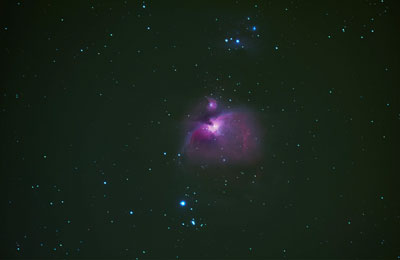Emission nebulae are vast clouds of hydrogen and helium, which are ionized by the high energy ultraviolet radiation of nearby stars. Electrons are excited for a short time to a higher energy level. When they fall back to their normal energy level they release the absorbed energy in the form of visible light again – they fluoresce.
The same process is working – although with other gases – in a neon tube, and just like a neon lamp, emission nebulae do not show a continuous spectrum of colors, but only emit light in a few colors. Fluorescent lights appear white because the colors of various gases in the fluorescent tube add up to white light. Emission nebulae contain only hydrogen and helium, so their spectrum is dominated by the emission lines of hydrogen. Therefore, they appear reddish on long-exposure photographs. Since their brightness is too low to be seen in color, they appear grey in the telescope.

Telescopes and some binoculars offer the ability to screw special UHC filters in front of the eyepieces. These filters only transmit light of hydrogen and so hide the flare of light pollution. But this is a very rare option with binoculars.
For the observation of nebulae you should choose an observing site which is as dark as possible, since they are usually quite extended and faint – so they can easily get lost in the background brightness of the sky. However, some large nebulae are easier to see in binoculars than in a telescope, even without special filters. Since they are very extensive, they can fill a large part of the field of view, so that they are difficult to distinguish from the sky background in the telescope. This is particularly true when they have no sharp demarcation, but fade slowly on the edge. They are therefore referred to just as diffuse nebulae, although this name also includes reflection nebulae (see below). Among the most famous emission nebulae are the Great Orion Nebula (M 42) and the very extensive North America Nebula (NGC 7000) in the constellation Cygnus. Especially the large nebulae can be hard to distinguish from their surroundings if the sky background is not completely dark.
